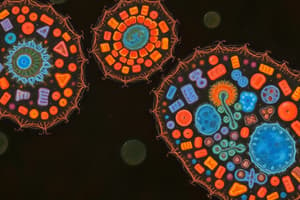Podcast
Questions and Answers
Where are proteins destined for the endoplasmic reticulum, the Golgi apparatus, lysosomes, the plasma membrane, and secretion from the cell synthesized?
Where are proteins destined for the endoplasmic reticulum, the Golgi apparatus, lysosomes, the plasma membrane, and secretion from the cell synthesized?
- In the Golgi apparatus
- On free ribosomes
- In lysosomes
- On ribosomes bound to the membrane of the endoplasmic reticulum (correct)
What is the function of the signal recognition particle (SRP)?
What is the function of the signal recognition particle (SRP)?
- To recognize and bind signal sequences of polypeptide chains (correct)
- To process proteins in the Golgi apparatus
- To facilitate protein folding in the endoplasmic reticulum
- To sort proteins to lysosomes
What is the main purpose of the co-translational pathway in targeting proteins to the endoplasmic reticulum?
What is the main purpose of the co-translational pathway in targeting proteins to the endoplasmic reticulum?
- To facilitate the recognition of signal sequences by the SRP (correct)
- To allow for post-translational modification of proteins
- To enable the transport of proteins to lysosomes
- To promote protein secretion from the cell
What is the common feature of the endoplasmic reticulum, Golgi apparatus, and lysosomes?
What is the common feature of the endoplasmic reticulum, Golgi apparatus, and lysosomes?
What is the typical location of signal sequences in polypeptide chains?
What is the typical location of signal sequences in polypeptide chains?
What happens to the SRP after binding to the SRP receptor on the ER membrane?
What happens to the SRP after binding to the SRP receptor on the ER membrane?
What is the function of the translocon in the ER membrane?
What is the function of the translocon in the ER membrane?
What is the characteristic of integral membrane proteins?
What is the characteristic of integral membrane proteins?
What is the fate of proteins destined for incorporation into the plasma membrane?
What is the fate of proteins destined for incorporation into the plasma membrane?
What is the effect of the hydrophobic transmembrane α helix on the translocon?
What is the effect of the hydrophobic transmembrane α helix on the translocon?
Flashcards are hidden until you start studying
Study Notes
Protein Sorting and Targeting in Eukaryotic Cells
- Protein sorting and targeting involve complex processes due to the internal organization of eukaryotic cells.
- The first step of protein sorting occurs during translation, while the polypeptide chain is still being synthesized.
Targeting Proteins to the Endoplasmic Reticulum
- In mammalian cells, most proteins enter the ER co-translationally, whereas in yeast, both co-translational and post-translational pathways are used.
- The amino acid sequence of the polypeptide chain being synthesized targets ribosomes for binding to the ER membrane.
- Signal sequences, typically 15-40 amino acids long, including 7-12 hydrophobic residues, are recognized and bound by the signal recognition particle (SRP).
- The SRP binds the ribosome, mRNA, and growing polypeptide chain, inhibiting further translation and targeting the complex to the rough ER.
Co-Translational Pathway
- The SRP binds to the SRP receptor on the ER membrane, triggering the hydrolysis of GTP bound to the SRP, releasing the SRP from the ribosome and signal sequence.
- The ribosome then binds to a protein translocation complex or translocon in the ER membrane, and the signal sequence is inserted into a membrane channel.
- The growing polypeptide chain is transferred through the translocon as translation proceeds, and the signal sequence is cleaved by signal peptidase.
Insertion of Proteins into the ER Membrane
- Proteins destined for the plasma membrane or membranes of compartments are initially inserted into the ER membrane instead of being released into the lumen.
- Integral membrane proteins are embedded in the membrane by hydrophobic sequences that span the phospholipid bilayer.
- The membrane-spanning portions of these proteins are usually α-helical regions consisting of 20-25 hydrophobic amino acids.
- The hydrophobic transmembrane α helix signals a change in the translocon, causing the membrane-spanning helices of the translocon to open and allowing the hydrophobic transmembrane domain of the protein to exit the translocon laterally.
Studying That Suits You
Use AI to generate personalized quizzes and flashcards to suit your learning preferences.




